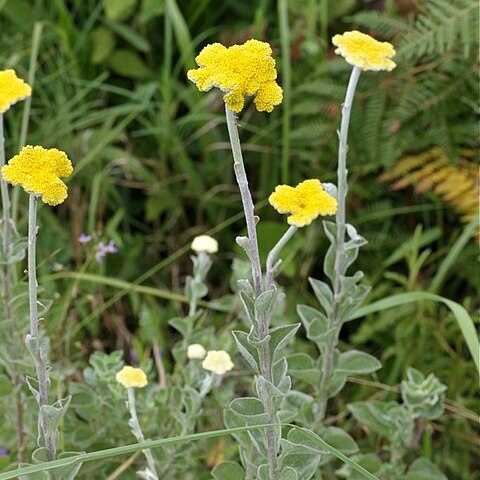Perennial herb, up to 1 m high; stems often decumbent and rooting, then erect, young parts thinly grey-woolly, leafy, nude only near flower heads. Leaves: blade variable in shape, narrowly obovate, elliptic, ovate or rhomboid-ovate, 20-80 x 3-25 mm, smaller upwards passing into bracts, apex acute or subacute, base attenuate, cuneate or abruptly petiole-like narrowed, ear-clasping; upper surface cobwebby or thinly to thickly greyish white-woolly and glandular-hairy, lower surface thickly greyish white-woolly, wool sometimes absent. Heads discoid, cylindric, ± 3 x 1 mm, many crowded and webbed together with white wool to form flattened umbrellalike disc. Involucral bracts in 2 series, subequal, loosely imbricate, ± equalling florets, not radiating, canary-yellow; outer often golden-brown, stereome divided. Receptacle epaleate, nearly smooth. Flowers: disc florets only, 3-6; corolla narrowly campanulate above, yellow; Jan.-Mar. Fruit with cypsela hairy. Pappus absent or of few barbellate bristles, bases not cohering.
Stems decumbent, rooting, then erect to ± 1 m high, young parts thinly grey-woolly. Leaves 20-80 x 3-25 mm, variable, mostly oblong-spathulate, narrowed basally, then expanded and ear-clasping, or tapering to a ± petiolar base, upper surface glandular-hairy, cobwebby or greyish white-woolly, lower surface thickly greyish white-woolly, or wool ± absent. Capitula cylindric, 3 x 1 mm, crowded into a flattened disc; involucral bracts biseriate, pellucid, outer ± golden-brown. Receptacle ± smooth. Flowers 3-6, yellow. Flowering time Jan.-Apr. Pappus of 0-7 bristles. Cypselae 0.50-0.75 mm long, barrel-shaped.
Perennial herb, up to 1 m high. Leaves 20-80 x 3-25 mm, variable in shape, upper surface cobwebby or thinly to thickly greyish white-woolly, lower surface thickly greyish white woolly, sometimes wanting. Heads cylindric, crowded together to form flattened umbrella-like disc. Flowers yellow; involucral bracts canary-yellow, outer often golden-brown.

